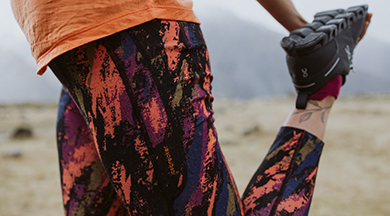Merino wool vs wool
29 October 2024
Merino wool is half a world away from regular wool, and as soon as you've worn your first merino piece you'll understand why. Its natural odour resistance, temperature-regulating properties, and moisture management abilities are superior to traditional wool, and its softness, strength, resilience, and all-season adaptability make it far removed from its classic woolly jumper cousins.
The word wool is a term to describe the natural fibers taken from the coats of certain animals to create a versatile textile, commonly used for clothing. The textile industry primarily uses 10 main natural wool types, including:
- • Traditional sheep's wool
- • Merino wool (sheep's wool from the merino breed)
- • Shetland wool (from a specific breed of sheep)
- • Lambswool (also including Virgin wool from young lambs)
- • Cashmere (from cashmere goats, pashmina goats)
- • Mohair (from the Angora goat)
- • Alpaca wool
- • Vicuña wool
- • Camel wool
- • Qiviut (muskox wool)
- • Llama wool
Merino wool comes from the hardy merino sheep, native to the harsh New Zealand bushlands, which provides its finer fibers with intrepid performance through its natural ability to thermoregulate, while staying soft and lightweight against skin.
In this article, we'll look at the different types of wool, from traditional sheep's wool to merino wool vs lambswool, and consider exactly what the difference between wool and merino wool will bring to your wardrobe.
What is wool and what makes it unique?
The term wool relates to the fibers taken from the coats of a variety of different mammals and encompasses fleece, cashmere, fur, tweed, and hair, as well as synthetic wool and recycled wool fibres. Wool itself is traditionally a natural product, which is made mostly from keratin proteins, offering warmth and durability when creating clothing and accessories. Although wool can be produced from many different animals, sheep's wool is the most commonly used material due to its insulating properties, fiber strength, and natural resistance to odors. Thanks to the lanolin coating on natural sheep's wool, it also offers moisture management abilities as well as some water-repellent characteristics, so it stays warm when wet.
Merino wool offers even more benefits than traditional wool, with superior moisture management and temperature regulation capabilities for all seasons, resilience for ultimate performance, and unbeatable softness without the scratchiness of standard sheep's wool. The main difference between wool and merino wool that people instantly notice is its breathability and softness— without the itchy or bulky feeling of traditional wool.
What is merino wool?
Merino wool, from the unique merino sheep, has famously finer fibres, which are more lightweight and feel soft when they touch your skin, meaning merino clothing is supremely softer and less scratchy than other wool types. This makes merino wool fabric ideal for activewear and next-to-skin layers for all the family.
When it comes to merino wool vs wool for clothing, there's little competition. Merino's natural thermoregulation makes it perfect for all seasons, whilst its effective moisture management and breathability mean it can be used for sportswear, outerwear, and everyday clothing and accessories. What's more, Icebreaker merino clothing is extremely soft, lightweight, machine washable, naturally odour resistant, and highly resilient for all sorts of outdoor adventures.
Comparing merino wool with other types of wool
You'll realise the difference between wool and merino wool as soon as you've touched or tried on your Icebreaker items. Its naturally soft fibres sit smoothly on your skin rather than being bulky and itchy like traditional sheep's wool. When it comes to soft cashmere or lambswool vs merino wool, there are also key differences to consider, primarily when it comes to resilience and overall performance. Let's look at the benefits of merino wool over other natural wool types, to find out why merino wool has become the preferred choice for next-to-skin layers, activewear, and outdoor essentials.
Softness and comfort
Merino wool is well known for its softness against your skin, thanks to its finer fibres, making it comfortable to wear all year round. When you compare the softness of merino wool vs lambswool or cashmere, it's important to consider the thickness of the fibres. Wool fibre diameter is measured in microns, and generally, the smaller the micron count, the softer the fabric will be. Regular wool has a much higher micron count, depending on the sheep breed, which can make it feel coarse, scratchy, and irritating against your skin.
At Icebreaker, we have a strict fibre criteria in order to produce the highest quality clothing. We specify fibre length, strength, diameter, consistency, colour, style, and cleanliness to ensure we get the right crimp and structure to create soft and smooth base layers.
Moisture management and breathability
Thanks to the rugged New Zealand landscape and disparate climate, merino wool offers a naturally effective way to manage moisture and regulate temperature. These clever fibres offer:
Temperature regulation: The insulating properties of the natural fibres adapt to your body and the weather, keeping you cool in summer and warm in winter.
Breathability: The lightweight fibres and natural weave shape allows air to circulate, supporting next-to-skin comfort as well as assisting with odour resistance.
Moisture management: Merino fibres absorb moisture from your skin, and release it into the air. Merino wool can absorb up to 35% of its weight in water before feeling damp, so it won’t weigh you down in the great outdoors.
Merino’s versatility makes it perfect for underwear, layering, outerwear and activewear, offering superior thermo regulation and moisture management than thicker, regular wool.

Weight and warmth
Merino wool is more lightweight than regular wool yet offers similar levels of warmth to other high-quality wools. Merino's finer fibres make it much lighter than regular wool types, and it provides effective insulation all year round, remaining lightweight even when wet.
You may think that lambswool vs merino wool would be more lightweight, but although lambswool generally has shorter fibres, the micron count can vary significantly, making merino the reliable choice when it comes to warm yet lightweight clothing fabrics.
Resilience and flexibility
Known for its resilience and versatility, merino fibres are highly flexible and hold their shape over time, which is what makes it a popular choice for activewear and base layers. Most of icebreaker’s resilient fabrics are machine washable, unlike cashmere and some traditional wools, which also lack the flexibility and lightweight appeal of merino. Merino wool’s strength, even when wet, makes it the ideal material for unbeatable performance outerwear for men, women and kids.
Is merino wool worth the investment?
Although other wool types also offer strength, durability, and warmth, merino wool is the truly versatile option. As well as exceptional warmth and breathability, it feels much softer against your skin, making it an ideal solution for next-to-skin layers and underwear as well as mid layers.
Icebreaker's merino range offers premium quality clothing and accessories which are built to last. As well as the superior comfort, versatility, breathability and softness you’ll enjoy for every wear - and for many years - its unrivalled moisture management and thermo regulating abilities make your icebreaker separates work hard for you in all conditions. Experience the comfort and performance of merino wool—browse our collection now.
Merino wool vs wool - FAQ
Is merino wool better than wool?
Merino wool features finer fibres, superior softness, and is more lightweight than traditional wool. Its premium finish, breathability, and versatility mean it won't irritate your skin like other wool types, and it offers thermo-regulating properties for a range of apparel for all seasons.
What are the disadvantages of merino wool?
Merino wool can be more costly than classic sheep's wool, but our clothing is built to last. Some merino wool types are trickier to care for, but Icebreaker clothing is machine washable and resilient. Discover more about Icebreaker's commitment to sustainability and animal welfare.
Is merino the warmest wool?
Cashmere is considered the warmest wool, but it is far less durable, making merino the preferred choice when it comes to performance. Some people also find regular wool hotter to wear, but this is due to merino's effective thermo-regulating properties, so you'll keep cooler wearing merino in warm weather.
Does merino wool get softer with washing?
Merino wool is naturally soft against your skin, but many people find that it feels even softer after washing. Washing your merino separates using a delicate detergent, and following the care instructions on the label, means you can maintain its softness and performance for as long as possible.
Is merino wool as itchy as regular wool?
Regular sheep's wool can feel itchy and scratchy against skin, but merino wool is different. Its soft fibres and delicate crimp mean it sits smoothly against the skin and isn't irritating, even when worn as underwear. When it comes to lambswool vs merino wool in the softness stakes, merino triumphs too.
More for you

What is merino wool
10 December 2024 | icebreaker

How to wash merino wool?
01 October 2024 | icebreaker

Merino wool benefits
29 November 2024 | icebreaker
More for you










